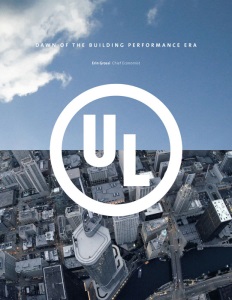
by Brianna Crandall — January 23, 2015—Global safety science leader UL recently conducted a study to learn where value and return on investment lie in the area of sustainable buildings. The study and its results are available in a free white paper titled “The Dawn of the Building Performance Era,” written by UL Chief Economist Erin Grossi.
In the white paper, Grossi predicts disruption in the building market over the next five to ten years as owners, operators and investors of buildings increasingly recognize the potential of innovation in building energy consumption, water usage and indoor air quality to positively impact their bottom lines. Grossi describes the transition that is happening in the market from design-driven approaches to achieving sustainability goals to a greater focus on the actual performance of buildings on the operations side of the house.
“Like many industries in the recovering global economy, the building industry is being forced to take a good look at what investments and practices are actually driving real and lasting value for investors, owners and tenants,” says Grossi. “Recent technology advancements in sensors, dashboards and integrated IP networks make the realization of energy and water savings and improved indoor air quality more financially viable and traceable. Access to more information about how efficiently buildings are being run can significantly reduce costs and slash consumption of resources for building owners.”
Grossi also addresses the issue of indoor air quality, which she refers to as a “sleeper issue” in the United States. She finds a major cause of poor indoor air quality is the growing amount of chemicals in buildings, which can emanate from technology hardware, construction materials, furniture and furnishings, and cleaning products. According to UL’s air quality scientists, there are 80,000 chemicals in international commerce today, with only three percent fully evaluated for health benefits.
“UL’s air quality scientists estimate we are easily within five years of having effective air quality detectors available for commercial use in buildings,” says Grossi. “Once air quality issues become more visible to employers and employees, the interest level will increase and activity will commence to study and mitigate the risks to human health.”
Building owners, facilities managers and investors are interested in improving indoor air quality as well, given the potential asset protection benefits and productivity benefits for occupants, notes Grossi.
This white paper provides an economic analysis and point of view from UL’s chief economist on the mega-trend of sustainable building. It is the result of a yearlong effort to combine secondary-source research with external engagement of C-Suite representatives from a wide range of organizations in the building value chain. By breaking down the forces of sustainable building and isolating the key drivers, the analysts were able to discern the likely trajectory of the building industry in terms of its implementation of sustainable performance practices and measures.
“The Dawn of the Building Performance Era” is available for download from UL’s online library. Watch the white paper’s video, “The Air We Breathe: UL Unlocks Building Performance,” on YouTube to learn more about the importance of smarter, healthier and safer buildings.




